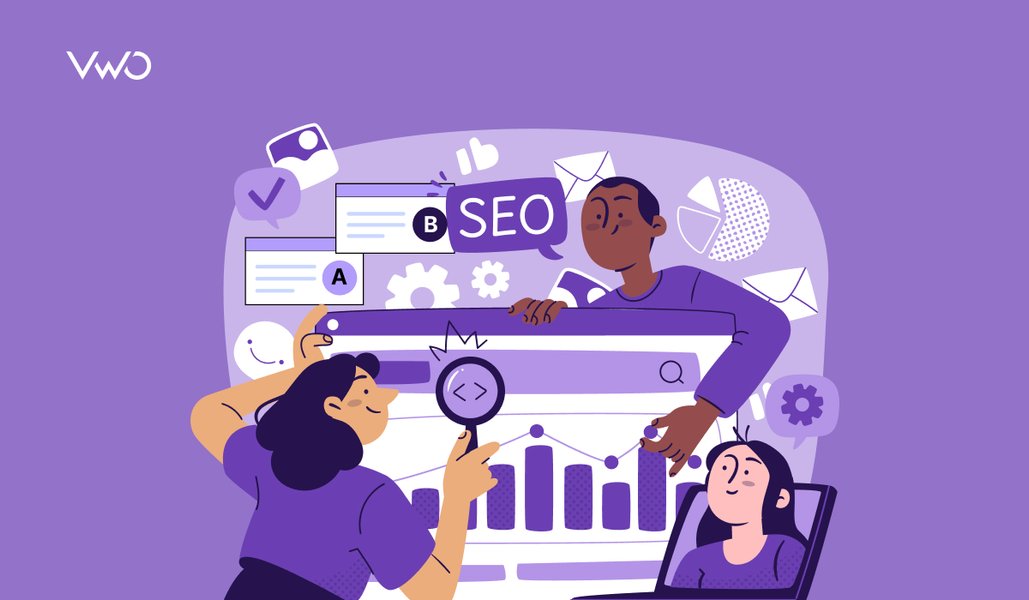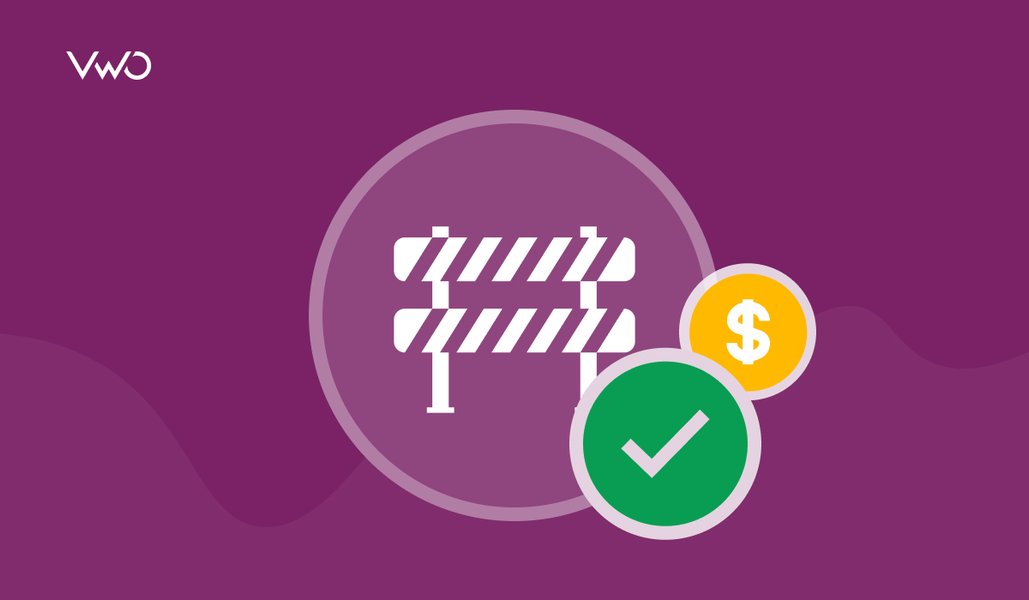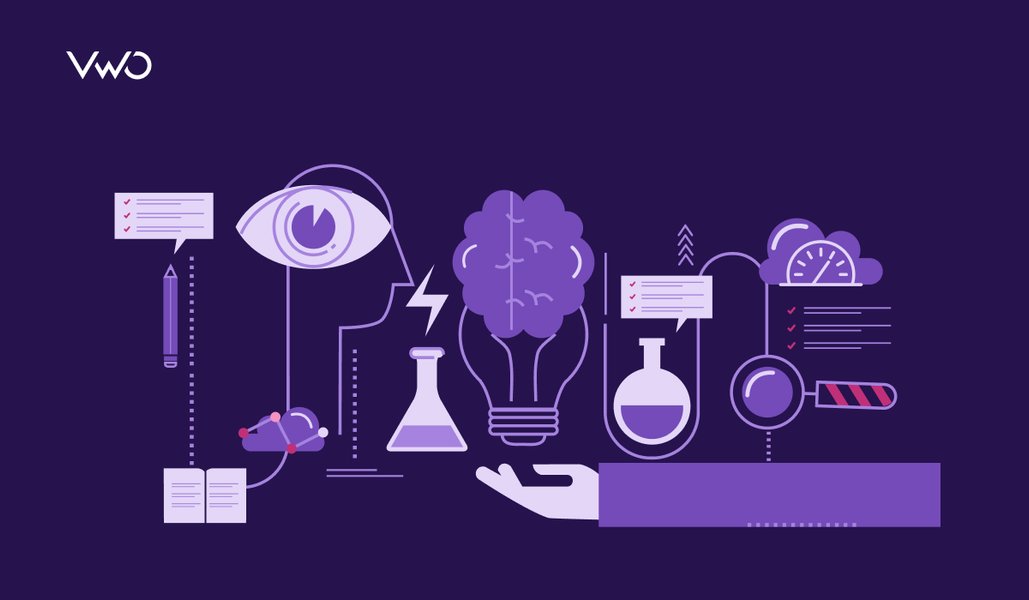Businesses that refuse to A/B test must either possess an extraordinary ability to foresee what users want or be fearless risk-takers.
Why else would they pass up a method that helps them implement website changes supported by data?
Any business that understands market trends and aims to reduce the risk of unvalidated decisions knows the value of testing.
If you’ve already taken the plunge, it’s time to focus on scaling those efforts. But if you haven’t started yet, now is the perfect moment to dive in.
The longer you wait, thinking you know best, the faster your competitors will leverage A/B testing and get ahead.
In this blog, we’ve compiled essential A/B test statistics to help you start or improve your A/B testing efforts.
Market overview
1. The global A/B testing tools market is projected to reach USD 850.2 million in 2024, with a compound annual growth rate (CAGR) of 14.00% from 2024 to 2031.
(Source: Cognitive Market Research)
More businesses are expected to invest in A/B testing tools, recognizing the importance of data-driven decision-making. To cater to this growing demand, platform vendors will keep innovating their products with cutting-edge features.
With vendors improving their offerings, it becomes difficult for businesses to choose the right tool. Based on your business needs—such as customization, integration, advanced features, price, and support—you should select a tool that fits well.
2. A/B testing is projected to generate up to $1.08 billion in revenue by 2025.
(Source: Truelist)
Companies that invest in the right tools, expertise, and strategies will be well-positioned to leverage this growth and stay competitive in an ever-evolving digital landscape. Preparing now with a structured approach to testing will ensure businesses can fully capitalize on this trend.
3. About 77% of firms globally conduct A/B testing on their websites.
(Source: Enterprise Apps Today)
This reflects a growing acceptance that customer preferences and behaviors can no longer be left to guesswork. Instead, businesses are embracing A/B testing as a strategic tool to fine-tune their digital experiences, improve conversion rates, and maximize ROI.
Elements to run A/B tests on
4. 60% of companies use A/B testing for their landing pages.
(Source: Leadpages)
A landing page is specifically designed to encourage visitors to take action, which can improve conversions, sales, or sign-ups. Testing your landing page helps you identify which elements appeal to users, allowing you to optimize the page and improve business metrics.
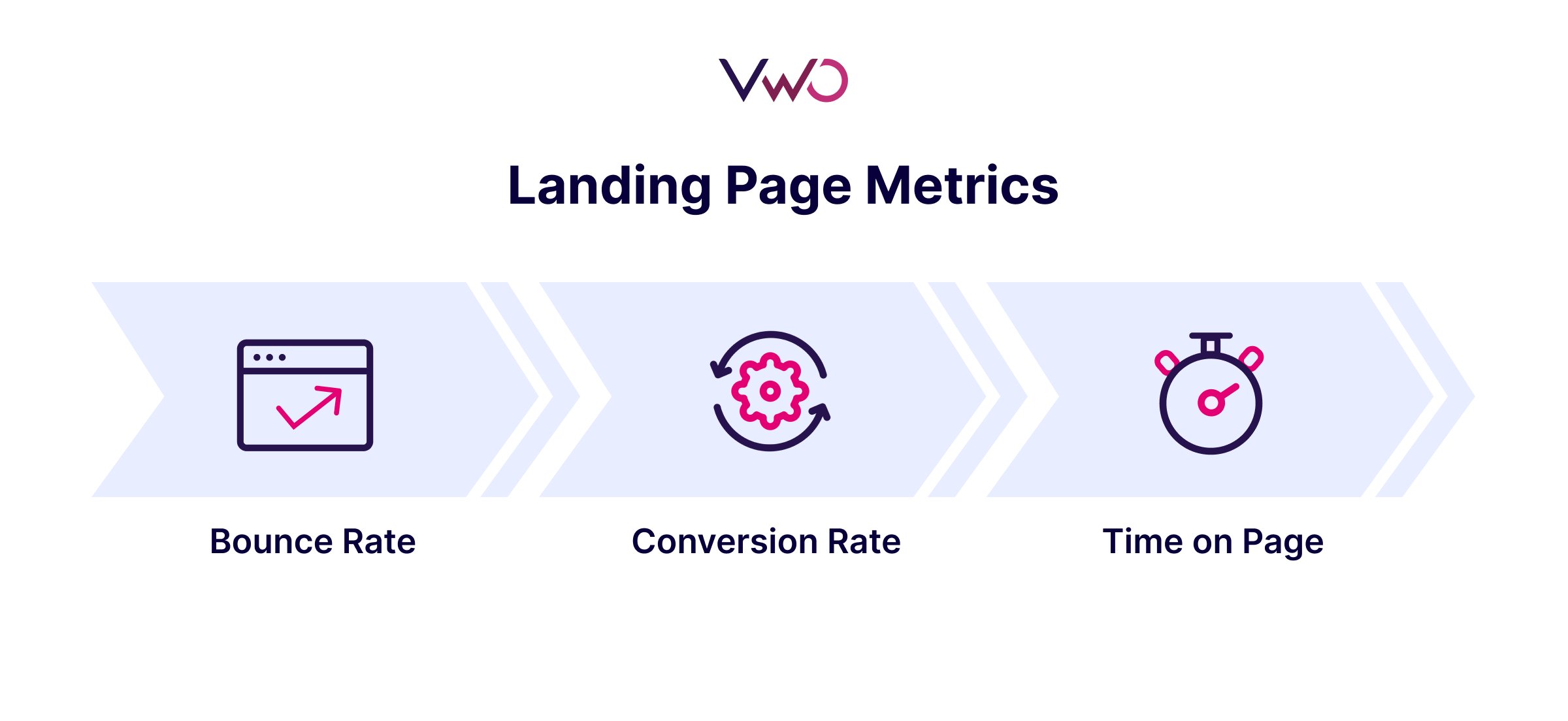
5. 59% of firms conduct A/B testing in their email marketing campaigns.
(Source: Enterprise Apps Today)
Personalizing your emails is important, but A/B testing to see what works is equally crucial. The number indicates that more firms are A/B testing emails, starting with body copy, subject lines, and offers.
This will help them understand what drives open rates and click-through rates. Based on these insights, they can improve their emails and deliver true values to their audiences.
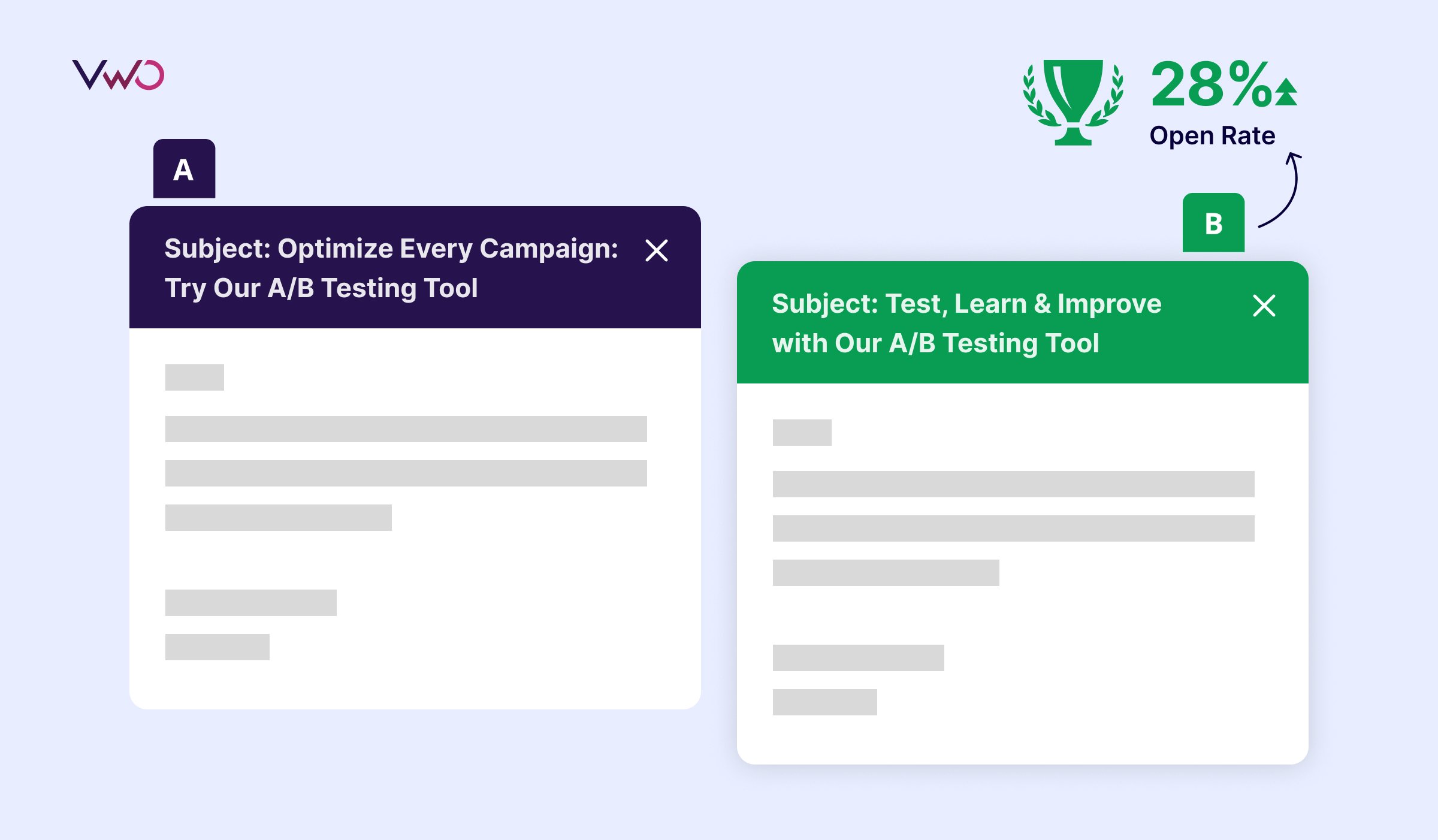
6. 85% of businesses prioritize CTA triggers for A/B testing.
(Source: Enterprise Apps Today)
This isn’t surprising — CTAs are the most basic elements to start testing with and often show great results. They can be easily implemented without needing extensive authorization from the top management and significant resources. It’s a great starting point for businesses targeting low-hanging fruit with A/B testing.
PriceCharting is a website that tracks current and historic prices for new and rare video games, charging users a small fee for pricing insights. On its product pages, PriceCharting changed the CTA text from ‘Download’ to ‘Price Guide.’
The variation led to an astounding 620.9% increase in click throughs! Why did they make this change? What rationale made such a small adjustment work so effectively? Read our detailed case study to find out.

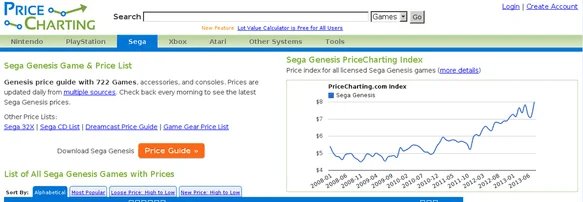
7. 58% of companies run tests on their paid ads.
(Source: Invesp)
Paid ads involve direct financial investments. No wonder companies are highly motivated to ensure their ads are performing well and generating the best possible ROI. A/B testing helps them refine ad elements—headlines, images, CTA buttons, and targeting—so they can increase click-through rates (CTR) while minimizing ad spends.
A/B testing trends across companies and industries
8. 71% of companies run two or more tests each month.
(Source: Invesp)
The number of tests you can run each month depends on your website traffic and available resources. Simply increasing testing velocity isn’t always feasible. It’s recommended to prioritize your testing ideas and automate tasks to increase your testing speed without compromising the quality of the tests.
Learn how the new gen-AI feature in VWO personalizes testing ideas based on your goals. This helps save time in brainstorming ideas and allows you to hit the ground running with implementation.
9. 63% of companies find A/B testing easy to implement, while 7% find it very difficult.
(Source: 99 firms)
Not having the right tools, integration issues with your tech stack, and limited technical knowledge can hinder your success with this approach. Deciding whether to outsource testing or manage it in-house depends on your company’s testing maturity. Read our blog and see what to consider before making this decision.
Easily integrate VWO with 40+ platforms, including CMS, CDP, analytics platforms, tag managers, and more, to create a seamless tech ecosystem for your company. This lets you send test data to other tools, helping you improve campaign targeting and gain useful insights for your business.
10. Approximately 52.8% of CRO professionals lack a standardized stopping point for A/B testing.
(Source: Enterprise Apps Today)
The duration for which a test should be run can’t be strictly dictated, as it depends on factors like sample size, minimum improvement in conversion, and the number of variations. However, not knowing when to stop a test is not ideal.
After a while, data can become outdated due to changes in user behavior and cookie deletions, making statistical test results harder to interpret. So, it’s best to set a testing duration and stick to it.
Check out our free A/B testing duration calculator to determine the ideal duration for your test. You can also check the statistical significance of your test to understand the threshold for accepting a winner and avoid selecting one by random chance.
11. An A/B test is considered significant after reaching 25,000 visitors.
(Source: FinancesOnline)
This is debatable and can’t be universally accepted as true. The required sample size for significance depends on factors like baseline conversion rate, minimum detectable effect, confidence level, and more.
While 25,000 visitors may be sufficient in some cases, it’s essential to calculate the appropriate sample size for each specific A/B test.
Have doubts? Use our calculator to know the right sample size for your test.
12. On average, SaaS companies run 24-60 tests per account every year.
(Source for statistics 13 to 17: A/B Testing Insights Report by VWO)
The fact that SaaS companies run up to 60 tests per account each year—averaging five tests per month—shows that they take testing seriously and prefer not to take risks.
This is commendable, given the strategic changes these companies often need to make around forms, pricing, and critical product pages. These decisions require extensive planning and vision, as they directly impact the bottom line.
A real case study –
Hubstaff, a project management software company, has embraced a culture of testing since 2015, consistently running small tests on individual elements. With an average of three tests per month, at least five experiments are always active on their website.
Seeking to advance their testing efforts, Hubstaff decided to conduct split testing (an advanced A/B test) on their control and variation homepages. This resulted in a remarkable 49% increase in sign-ups.
The team said that they would continue A/B testing smaller elements, like a copy, showcasing the commitment of SaaS companies to a testing culture.
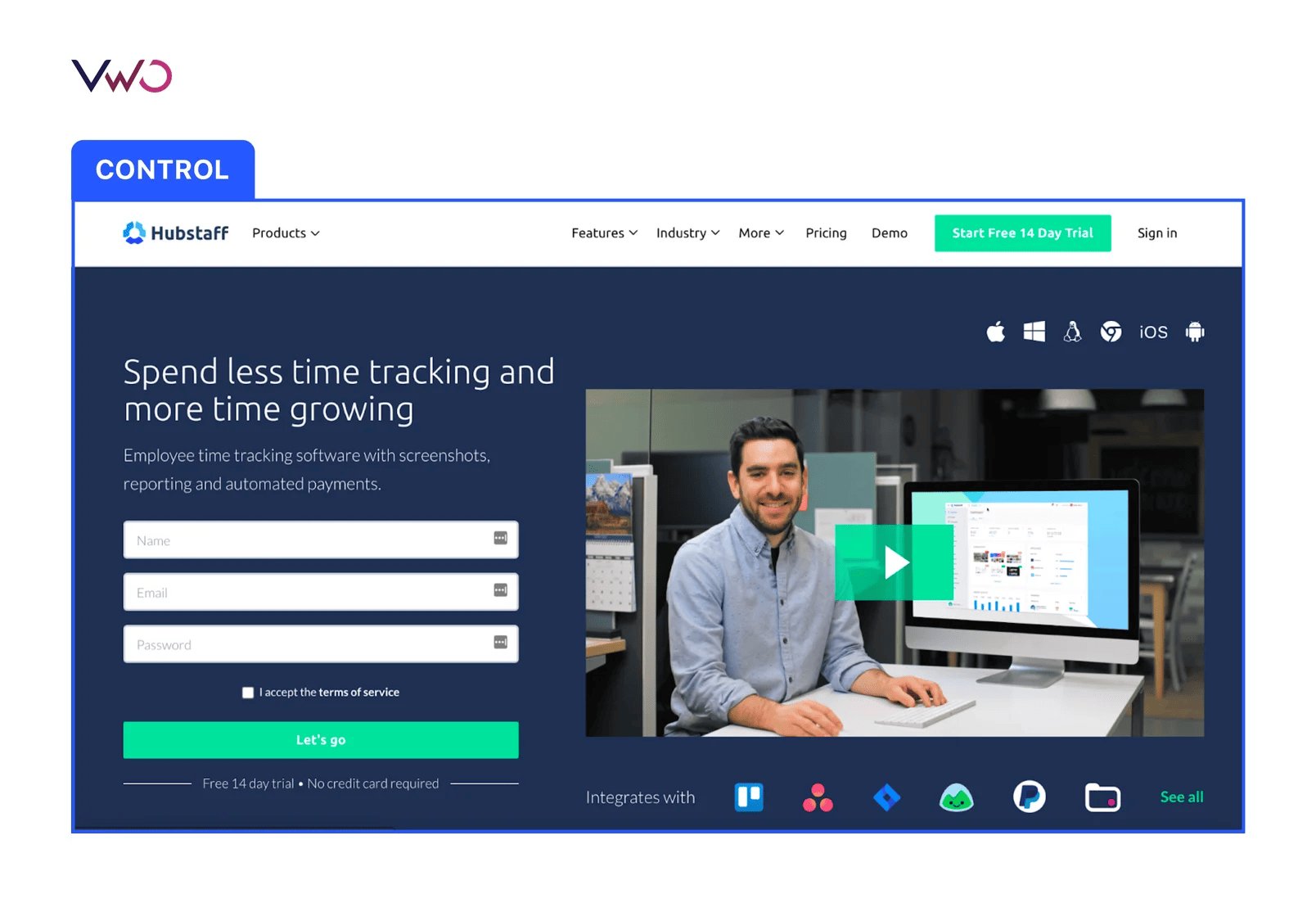
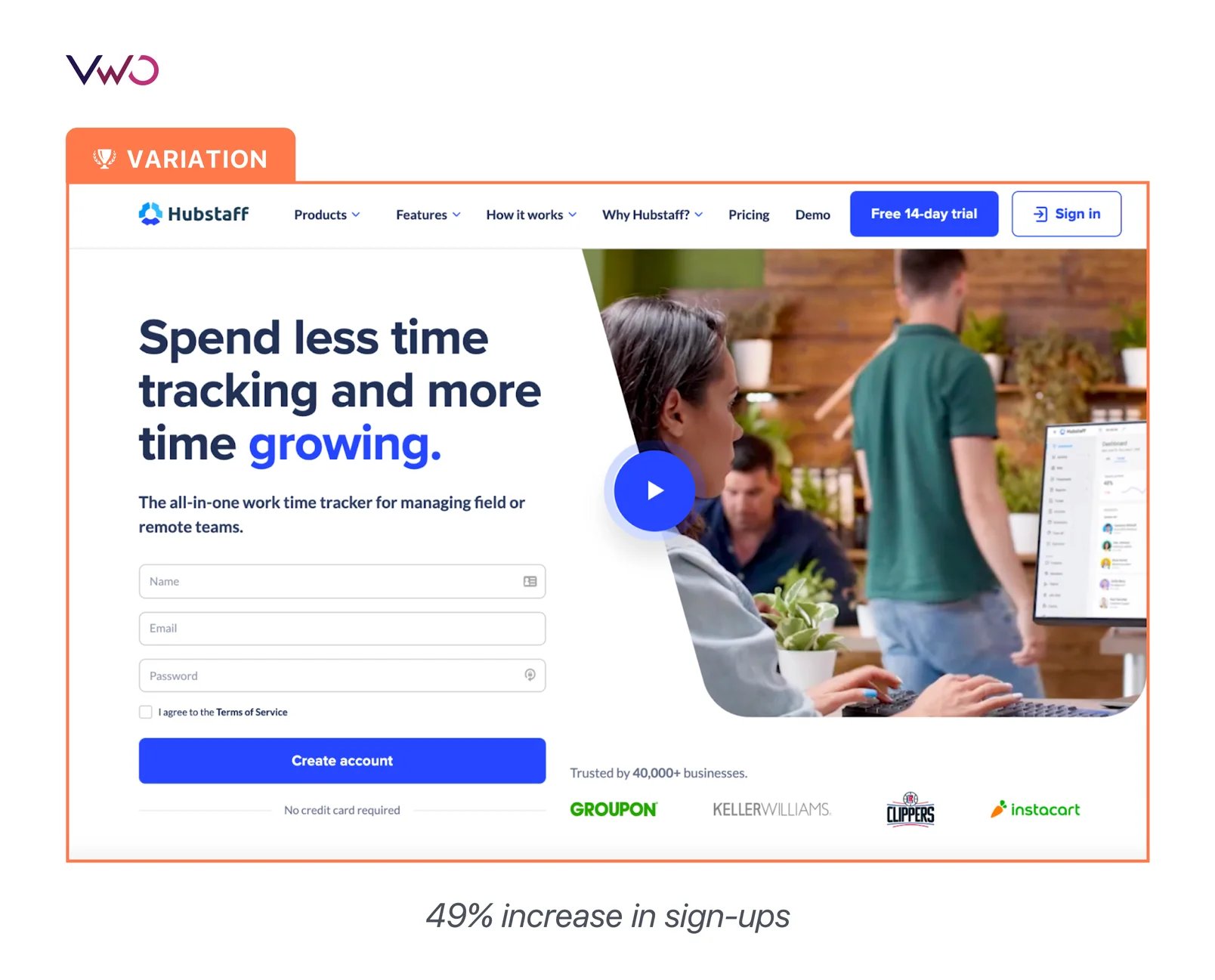
13. In the travel sector, only 40% of their test variations outperform the controls.
While it may seem upsetting that the travel sector doesn’t see as many tests with winning variations, it’s still better than not testing at all.
At least they can stick to the original version instead of making hasty unvalidated changes. This should be viewed positively—after all, in experimentation, we either have winners or gain insights. There are no losers in failed tests, only learning opportunities.
14. In the gaming and sports industries, 60% to 70% of tests have variations that outperform the controls, with engagement being the most common experiment goal.
By testing, these companies understand how to keep their audiences engaged on their websites. If you are in this industry, you can start with improving user onboarding, navigation, in-game features, scale to testing subscription plans, and pricing strategies.
A case in point –
The Portland Trail Blazers, a National Basketball Association (NBA) team, aimed to optimize their conversion funnel and boost online ticket sales. They identified several usability issues that hindered the ticket-purchasing process.
They hypothesized that redesigning the navigation menu would reduce visitor confusion, directing more traffic to the ‘Individual Tickets’ page. This effort led to a statistically significant 62.9% increase in revenue.


15. The average number of experiments run in the media and entertainment industry exceeds 60 per year.
Running a substantial number of experiments allows these companies to continually refine their offerings and respond to audience preferences quickly. It also indicates a healthy loop where insights gained from previous tests can inform future testing initiatives. This approach helps you build a pipeline of research-based testing ideas for optimal conversions.
16. Retail companies allocate more than 90% of their traffic to testing, highlighting its importance.
Having more visitors participate in testing significantly enhances the quality of data collected, leading to more reliable and statistically significant results. A larger sample size captures diverse behaviors and preferences, providing a comprehensive understanding of customer needs.
Our A/B Testing Industry Insights Report includes results from a study of over 1 million tests conducted on 100,000 websites. Download the eBook to discover more insightful A/B testing data across various industries!
Experimentation maturity among businesses
A/B testing often initiates a company’s journey into experimentation, paving the way for more advanced methods of statistical testing. By understanding the stages of experimentation maturity, organizations can pinpoint gaps and enhance their testing strategies. Here are some interesting experimentation statistics –
17. Approximately 0-20% of businesses are classified as ‘Beginners’, with few foundational elements for effective experimentation.
(Source for statistics 18 to 26: Benchmark and Scaling Testing in 2024)
Businesses at this stage lack the foundational infrastructure to run meaningful experiments.
The first step is to establish the basic foundations of an experimentation program. This involves adopting A/B testing tools, raising awareness of experimentation benefits, and ensuring teams understand how to run and interpret tests.
Setting clear goals and starting with small, low-risk experiments can help you get initial successes, which will build momentum for further testing initiatives.
18. Approximately 21-40% of businesses are ‘Aspiring’, having established some essential elements but facing internal hurdles.
Aspiring businesses should focus on breaking down silos between departments and aligning key stakeholders on the value of experimentation. Establishing cross-functional teams and encouraging open communication will help reduce internal friction and promote collaboration.
19. Approximately 41-60% of businesses are ‘Progressive’, recognizing the value of insight-driven experiments with basic foundational elements in place.
To scale their testing, these companies should refine their processes instead of getting complacent. Steps include improving test hypotheses and running more frequent and varied tests. Additionally, it’s important to ensure a robust feedback loop to gather insights from both successful and failed experiments.
20. Approximately 61-80% of businesses are Strategic, employing a comprehensive approach to experimentation with strong organizational support.
These businesses have already gained organizational support for testing. To maintain this, businesses should consistently uphold clear standards and regularly review their testing practices.
Providing ongoing training keeps the team skilled and informed, while thorough documentation of results ensures transparency. Moreover, maintaining open communication about progress and challenges reinforces management’s confidence in the team’s capabilities.

21. Approximately 81-100% of businesses are ‘Transformative’, leading the industry with an effective experimentation program that consistently delivers results.
Transformative businesses are industry leaders in experimentation, but continuous improvement is key to maintaining that status.
They can explore cutting-edge methods like AI-driven experiments, personalization, and multivariate testing. These companies should also focus on sharing knowledge company-wide and mentoring less mature departments to elevate overall organizational experimentation.
22. 49% of respondents believe their business culture lacks support for innovation, experimentation, and learning from failure and success.
Leadership needs to champion the value of learning from both successes and failures, emphasizing the long-term benefits of testing. Promoting experimentation success stories and embedding the concept of “test and learn” into the company’s mission can also shift the mindset towards innovation.
23. 50% of respondents do not have a repository or knowledge base for experimentation.
Businesses without a central repository should invest in building one. This can be a simple internal platform or an advanced software solution where past test results, insights, and recommendations are stored.
This will ensure that learnings are shared across teams, preventing duplication of efforts and encouraging more data-driven decision-making.
VWO offers a free built-in project management tool for tracking tests, managing backlogs, and sharing updates within teams. Read more about the VWO Plan.
24. While 65% of brands strongly agree their setup supports testing across their site or app, 31% of strategic-level brands disagreed.
Strategic-level brands have likely advanced in their experimentation journey and require more sophisticated, fine-tuned testing capabilities. These businesses might find their current infrastructure insufficient because their testing needs are far more complex.
They may face challenges in scaling after reaching great heights. For these companies, improving their testing strategies without burnout is important to stay competitive and continue innovating.
25. 46% of teams somewhat or strongly agree they have a robust test management system in place.
Teams should first assess their current testing processes to identify inefficiencies. Implementing specialized test management tools can streamline workflows and enhance collaboration.
Providing training on best practices will empower team members to utilize these tools effectively. Further, establishing standardized procedures for test planning and execution will ensure consistency across projects.
Speero collaborated with VWO to benchmark over 200 testing programs, uncovering insightful findings and impressive data. Download the eBook to get all the details!
Inspiration from leading companies
(Source: FinancesOnline)
26. Dell reported a 300% increase in conversion rates from A/B testing.
27. Bing conducts over 1,000 A/B tests monthly.
28. Google first implemented A/B testing in 2000 to determine the optimal number of search results per page.
29. Google, Amazon, Facebook, and Booking.com each conduct over 10,000 controlled experiments annually.
Conclusion
I hope these stats make you rethink your A/B testing strategy and highlight how rapidly the market is growing as more businesses embrace it.
Will A/B testing put you ahead of your competitors? Well, that takes patience and consistent effort. But will it keep you ahead of those relying on guesswork and gut feelings? Absolutely!
Implementing changes without validating them can seriously hurt your conversions and sales. Why gamble with your resources when you can make informed data-driven decisions? Embracing A/B testing isn’t just smart; it’s essential for staying competitive.
Request a demo to see how VWO can aid in your A/B testing journey.



